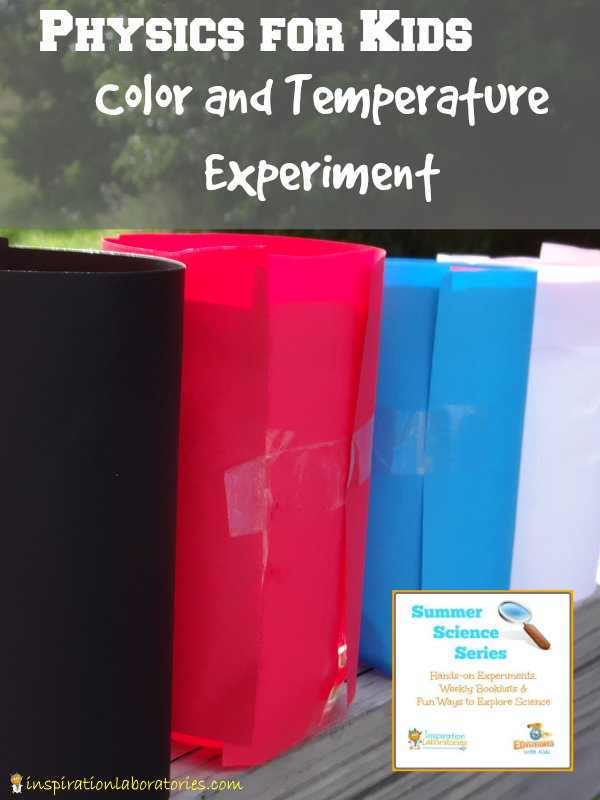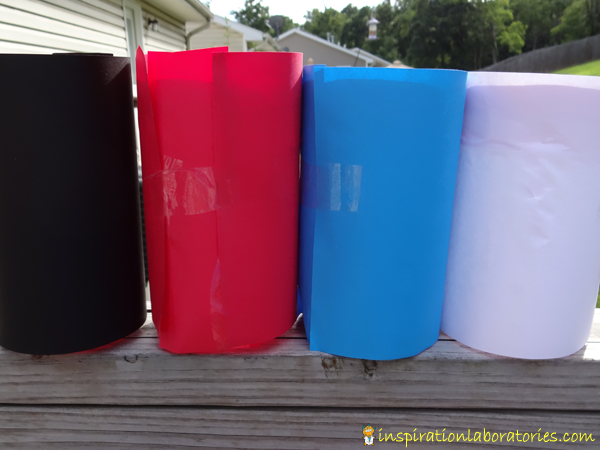Physics for Kids: Exploring Color and Temperature
Physics is the theme for week 4 of our Summer Science Series with Edventures with Kids. Today we’re exploring color and temperature with a fun experiment. Affiliate links are included in this post.
Heat Wave
Heat Wave by Eileen Spinelli and illustrated by Betsy Lewin tells the tale of the town of Lumberville. A heat wave has hit the town. The townspeople try to cope but the heat just won’t let up. Eventually, they all wind up by the river dreaming about rain. This book got us talking about the heat of summer. I thought it was the perfect springboard for an experiment about heat and temperature.
Here are two more related books we enjoyed.
 |
 |
- Heat Wave
by Helen Ketteman is quite hilarious. A heat wave is wreaking havoc on the farm. The corn is turning into popcorn; the cow’s milk is turning into butter; flowers get up and walk to the shade. A young girl saves the day. Everything in this book is exaggerated and that just makes it extra fun.
- Experiments with Heat
by Salvatore Tocci. This book has 9 experiments that explore heat. The experiments are a fun hands-on way for kids to learn about conduction, absorption, the greenhouse effect, and more.
Physics for Kids: Exploring Color and Temperature
How does color affect the temperature of an object? Conduct an experiment to find out. You’ve probably noticed that on sunny days, you feel a little cooler in a white shirt than a black shirt. This is because white reflects all wavelengths of light {colors}. Black absorbs all of the wavelengths of light. We tested the temperature change of containers of water covered with different colors of paper. Here’s what we did.

Supplies:
- Containers (we used peanut butter jars)
- Water
- Paper of different colors (white, black, and any other colors of your choice)
- Scissors
- Tape
- Thermometer (we used an instant read infrared thermometer)
Directions:
- Fill 4 containers with water. Be sure the temperature of the water is the same. What is their starting temperature?
- Cover each container with a piece of paper.
- Place the containers in direct sunlight or under a lamp.
- Wait about an hour and then measure the water temperature. {You could also test their temperature every 5-10 minutes to observe what happens.}
Our jars of water started at 72°F. After an hour or so in direct sunlight, we measured the temperature of the water. The water in the jar covered with black paper had a temperature of 75°F. The water in the red and blue jars had a temperature of 74°F. The water in the jar covered with white paper had a temperature of 72°F.
We currently have a break from the summer heat. Our high on this day was only 75°F. How would a hotter day have impacted the results? We used evening sunlight. How would morning or afternoon sunlight affect the results?
Remember that white reflects light, so the water temperature should be the lowest under the white paper. Black absorbs light, so the water temperature should be the highest. Other colors reflect and absorb light differently depending on how much pigment they have and a host of other factors. The results with other colors will vary.
Summer Science Series Weekly Reading Themes
Week 1: Biology
- Backyard Earthworm Experiments
- Kids’ Books and Websites about Biology over at Edventures with Kids.
- Growing Vegetable Soup at Read Science
- Easy Earthworm Science Experiment
- How to Attract Fireflies
Week 2: Geology
- Rock Collecting
- Kids’ Books and Activities About Geology at Edventures with Kids
- R is for Rocks {part of our A to Z Science series for toddlers and preschoolers}
- Sediment Observations and Learning about Dirt at Read Science
Week 3: Astronomy
- Learn about the Sun, Moon, and Earth
- Astronomy Activities for Kids with a list of books about stars at Edventures with Kids
- Make a model of the solar system with this planet order activity.
- Play a Planet Board Game to learn about the planets.
Week 4: Physics
- Physics for Kids: Exploring Color and Temperature
- Exploring Physics with Kids with a cool sink and float activity at Edventures with Kids
- A collection of physics experiments and activities for preschoolers
Week 5: Chemistry
- Kitchen Chemistry Experiment: Make a Cup Cake
- Chemistry Experiments for Kids with CO2 from Edventures with Kids
- More Kitchen Chemistry ideas
- 20 Baking Soda Experiments
Week 6: Ecology
- Ecology for Kids: Food Chain Lesson
- Learn about Biomes plus Ecology Books and Resources at Edventures with Kids
Subscribe to our weekly newsletter and get exclusive science explorations for young scientists in each issue.
![]()





Leave a Reply